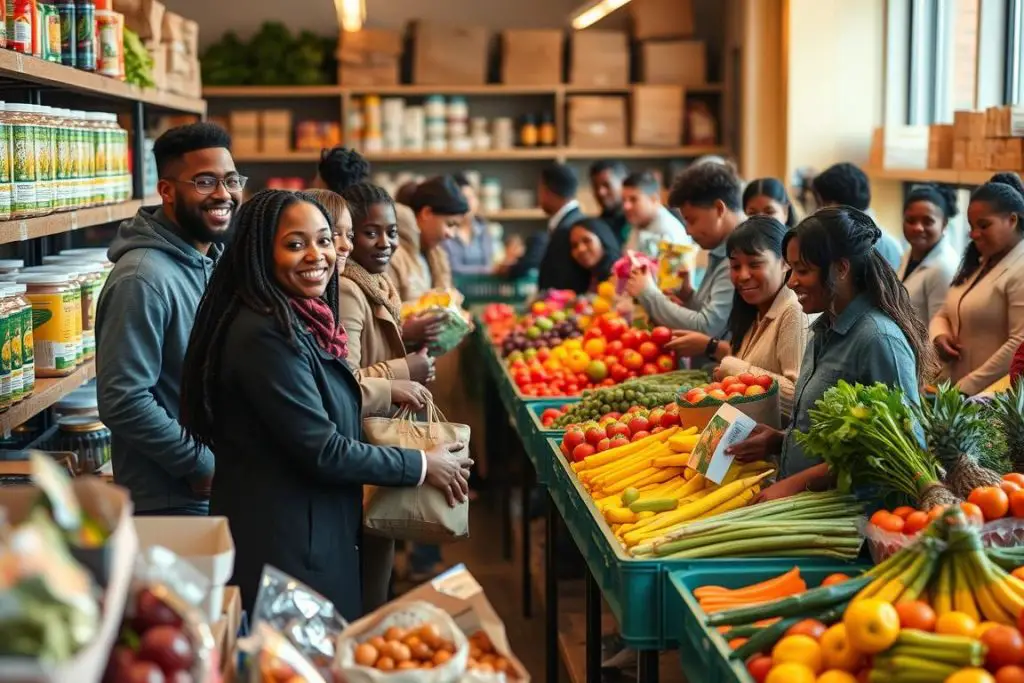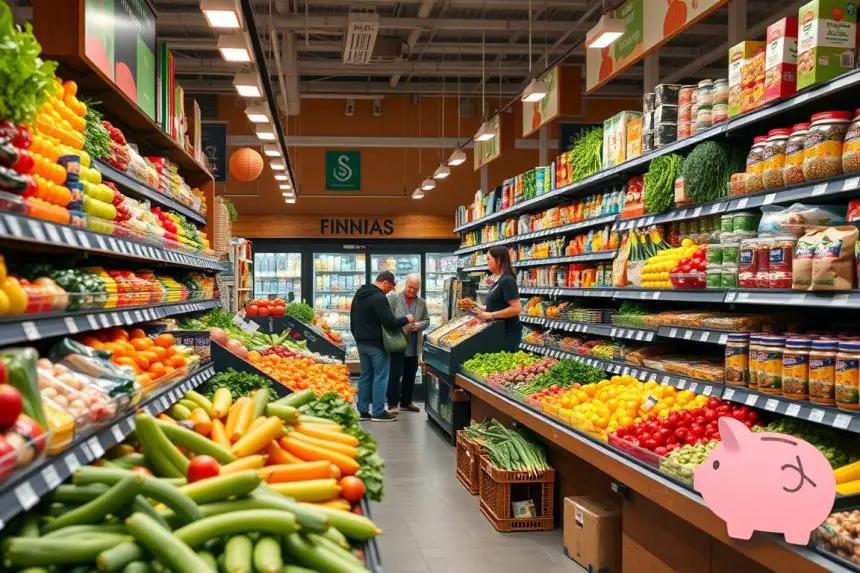Nearly one in eight American homes don’t have enough food. The American Rescue Plan gives up to $1,386 each month for groceries1. This extra cash can help make your budget stretch further. Alongside the SNAP program, the American Rescue Plan helps Americans who find it tough to cover bills2. By knowing which government programs are available, you can make sure your family eats well and stays healthy.
Key Takeaways
- You could claim up to $1,386 monthly for groceries with financial assistance programs.
- The American Rescue Plan is crucial for providing grocery support to millions of households2.
- SNAP benefits average up to $713 monthly for a family of four2.
- Eligibility and benefits vary based on household size and income levels2.
- Recent changes to SNAP eligibility may impact your benefits2.
- Maximize your grocery budget with tips and additional support programs.
The American Rescue Plan and Other Government Assistance Programs
The American Rescue Plan (ARP) is key in the federal effort to help Americans hit by the pandemic’s economic effects. It offers stimulus checks, help for small businesses, and more food aid. This plan supports Americans in getting back on their feet.
Overview of The American Rescue Plan
The ARP brings wide-ranging support. Families can get stimulus checks. A typical family of four with a household income under $110,000 gets about $5,6003. Plus, there’s a child tax credit: $3,000 for kids over 6 and $3,600 for those under 63. This helps families through tough times3. For small businesses, especially restaurants, new grants are available. These grants help keep businesses running3.
Unemployment benefits are also extended. People out of work can get an extra $300 per week until September 6, 20213.

Understanding SNAP Benefits
The Supplemental Nutrition Assistance Program (SNAP) is vital. It offers emergency food help to over 42 million people in 2023. Families get nutritious food with its help. The ARP adds about $28 more per month per person for SNAP4. This means $1.15 billion goes to states for the program4. On average, each person gets about $202 monthly. Larger families can get up to $1,386, aiding them in buying groceries3.
Recent Changes to SNAP Eligibility
Changes from the Fiscal Responsibility Act have updated SNAP’s rules. Now, more people can get food aid due to altered financial rules. The Act raises the work requirement age for certain adults without kids. These changes aim to expand access to food aid3.
SNAP benefits have also been increased. This means better support for families needing emergency food help3. The ARP has set aside $880 million to improve moms and babies’ access to fruits and vegetables under WIC4.
Financial Support for Groceries: How to Apply and Maximize Your Benefits
Getting help with grocery bills can make life easier for families. The process to get this help, like SNAP, seems hard at first. But, it’s set up to help those who really need it, fast.
Application Process for SNAP
To apply for SNAP, send your application to a local office, then there might be an interview. They’ll ask for ID, proof of income, where you live, and your bills. It usually takes up to 30 days in California to process, but some can get help in just three days if they really need it5. For quicker aid, TANF helps with food, clothes, a place to live, and getting around. Visit the Your Texas Benefits website for more about TANF6.
Maximizing SNAP and Other Benefits
After getting SNAP, you can use an EBT card at many stores. To make the most of it, keep up with program updates and look for extra help. The USDA added 45 days for SNAP reviews to help with social distancing6. SNAP now lets you shop online in almost all states6. The Families First Act stopped work rules for some during the pandemic, offering more help6. Also, LIHEAP can help pay utility bills, so you have more for groceries.
Tips for Stretching Your Grocery Budget
Smart shopping can help the support from SNAP and other programs go further. Try cooking your favorite fast food at home to save money. Making your own chicken sandwiches, cheeseburgers, and pizza cuts dining out costs. Also, food pantries and emergency food programs like TEFAP and CSFP offer more support6.
In California, fast help is available through CalFresh and cash aid for emergencies like being homeless or not having enough food. Homeless folks can get more help if they show they have housing costs5. These extra resources help you keep your food budget in check.
Conclusion
Understanding the American Rescue Plan (ARP) and SNAP can give you vital help with food costs in tough times. These programs are key to helping you buy food regularly, easing the worry over healthy eating. Knowing how to apply and keeping up with eligibility changes can boost your benefits and food security.
The USDA found about 6,500 food deserts from 2000 to 2006, showing why easy access to grocery aid matters7. Also, around 23.5 million Americans live far from big grocery stores, highlighting the value of good food assistance7. This guide prepares you to navigate these programs, helping you save on groceries and improve your meals.
Using government aid wisely can change how you manage money. USDA surveys show different levels of food security, shedding light on how tight finances shape family life8. Using benefits like SNAP can lead to healthier, more affordable eating habits. As efforts grow to offer better food choices in needy areas, this information lets you make savvy food assistance choices.
To learn more about how money shapes nutrition studies and health, look into research on funding influences. It shows why more independent money is needed to avoid biases. To learn more, check out this detailed article on the subject7.
FAQ
What types of financial support for groceries are available through the American Rescue Plan?
The American Rescue Plan helps with grocery bills through stimulus checks, Child Tax Credits, and more SNAP benefits. These efforts are designed to support those struggling with the economic impact of the pandemic.
How much can I receive in SNAP benefits for grocery assistance?
An individual can get about 2 a month from SNAP, and a family of four might get up to 3. For bigger families, the amount can go up to
FAQ
What types of financial support for groceries are available through the American Rescue Plan?
The American Rescue Plan helps with grocery bills through stimulus checks, Child Tax Credits, and more SNAP benefits. These efforts are designed to support those struggling with the economic impact of the pandemic.
How much can I receive in SNAP benefits for grocery assistance?
An individual can get about $202 a month from SNAP, and a family of four might get up to $713. For bigger families, the amount can go up to $1,386. This helps a lot with grocery shopping costs.
What are recent changes to SNAP eligibility under the Fiscal Responsibility Act?
The Fiscal Responsibility Act has made it easier for more people to get SNAP. It has done this by changing rules for adults who can work but don’t have kids, and by allowing for more food aid.
How can I apply for SNAP benefits?
To apply for SNAP, you send an application to your local state or county office. Sometimes, you’ll have to do an interview after. You need to show things like ID, where you live, and how much money you make. If you really need help fast, they can speed up your application.
Are there other food assistance programs besides SNAP?
Yes, there are. Programs like LIHEAP might help too. Food pantries also give quick help to families who don’t make much money.
How can I maximize my SNAP benefits and other financial help for groceries?
To make the most of your benefits, shop smart. Look for sales and buy foods that are good for you but don’t cost a lot. Try cooking meals at home that you’d normally eat out. This can save you money.
What tips can help stretch my grocery budget further?
Plan your meals, buy things in large amounts, use coupons, and cook at home to save money. Homemade spicy chicken sandwiches, cheeseburgers, or pepperoni pizzas can be cheaper than takeout. This way, you can keep more money in your pocket.
How do emergency food assistance programs work?
Emergency food programs give fast help when people urgently need it. SNAP can speed up its process for those in a crisis. Food pantries provide groceries right away, without lots of paperwork.
,386. This helps a lot with grocery shopping costs.
What are recent changes to SNAP eligibility under the Fiscal Responsibility Act?
The Fiscal Responsibility Act has made it easier for more people to get SNAP. It has done this by changing rules for adults who can work but don’t have kids, and by allowing for more food aid.
How can I apply for SNAP benefits?
To apply for SNAP, you send an application to your local state or county office. Sometimes, you’ll have to do an interview after. You need to show things like ID, where you live, and how much money you make. If you really need help fast, they can speed up your application.
Are there other food assistance programs besides SNAP?
Yes, there are. Programs like LIHEAP might help too. Food pantries also give quick help to families who don’t make much money.
How can I maximize my SNAP benefits and other financial help for groceries?
To make the most of your benefits, shop smart. Look for sales and buy foods that are good for you but don’t cost a lot. Try cooking meals at home that you’d normally eat out. This can save you money.
What tips can help stretch my grocery budget further?
Plan your meals, buy things in large amounts, use coupons, and cook at home to save money. Homemade spicy chicken sandwiches, cheeseburgers, or pepperoni pizzas can be cheaper than takeout. This way, you can keep more money in your pocket.
How do emergency food assistance programs work?
Emergency food programs give fast help when people urgently need it. SNAP can speed up its process for those in a crisis. Food pantries provide groceries right away, without lots of paperwork.
Source Links
- Aligning Programs and Policies to Support Food Security and Public Health Goals in the United States – https://www.ncbi.nlm.nih.gov/pmc/articles/PMC6784838/
- FoodShare: Your Income Could Make You Eligible – https://www.dhs.wisconsin.gov/foodshare/fpl.htm
- American Rescue Plan | The White House – https://www.whitehouse.gov/american-rescue-plan/
- American Rescue Plan – https://www.usda.gov/arp
- Initial Application for Calfresh , Cash Aid , and/or Medi-cal/health Care Programs – https://www.cdss.ca.gov/cdssweb/entres/forms/english/saws_1.pdf
- Food Assistance – https://www.usda.gov/coronavirus/food-assistance
- Food deserts: Definition, effects, and solutions – https://www.medicalnewstoday.com/articles/what-are-food-deserts
- USDA ERS – Measurement – https://www.ers.usda.gov/topics/food-nutrition-assistance/food-security-in-the-u-s/measurement/




